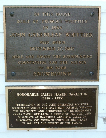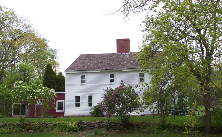
Haverhill MA and the Abolition of Slavery
The life of John Greenleaf Whittier
In 1839, Whittier became a founding member of the Liberty
Party. Within four years, the Party was exerting considerable influence
within the anti-slavery lobby, and could count upon the moral support
of such literary luminaries as Henry Wadsworth Longfellow and Ralph Waldo
Emerson.
In 1845, he began writing his essay The Black Man which included an anecdote
about John Fountain, a free black who was jailed in Virginia for helping
slaves escape.
The passage of the Thirteenth Amendment in 1865 ended both slavery, and
thus Whittier’s cause, so he turned to other subjects for his poetry
for the remainder of his life. One of his most enduring works, Snow-Bound,
was first published in 1866, and Whittier was surprised by its financial
success - the first edition earning him some $10,000.
Whittier died on September 7, 1892, at a friend's home in Hampton Falls,
New Hampshire, and he is buried at Amesbury, Massachusetts. Whittier's
birthplace, John Greanleaf Whittier Homestead, is now an historic site,
open to the public.
Perhaps Haverhillís most
famous son is the poet John Greenleaf Whittier, who is best known for
his poem Snow-
Whittier was born
into a Quaker family on 17th
December 1807, his parents being John and Abigail who had a small homestead
just outside the town. John junior was somewhat frail, and not
cut out for farm work, added to which he suffered from ill-
He received little in the way of formal education, his main font of knowledge being his fatherís books on Quakerism.
Home of John Whittier
Whittier
was first introduced to poetry by a teacher, and his first poem, The
Exileís Departure, was sent (unbeknown
to him) to the local Newburyport Free
Press by his sister. It was duly
published on 8th
June 1826, and the paperís editor, the anti-
Whittier attended Haverhill Academy
from 1827 to 1828 and, amazingly, completed his high school education
in only two terms.
After leaving the Academy,
Garrison secured Whittier the job of editor of the National
Philanthropist, a Boston-
In 1833, Whittier published the antislavery pamphlet Justice
and Expediency, and from thereon dedicated the next twenty years of his
life to the abolitionist cause.
He was a founding member of the American Anti-slavery Society, and signed
the Anti-slavery Declaration of 1833, which he often stated was the most
significant action of his life.
From 1835 to 1838, he travelled widely in the North, attending conventions,
securing votes, speaking to the public, and lobbying politicians. As he
did so, Whittier received his fair share of violent responses, being several
times mobbed, stoned, and run out of town! From 1838 to 1840, he was editor
of The Pennsylvania Freeman in Philadelphia, one of the leading anti-slavery
papers in the North.
HAVERHILL MASSECHUSETTS USA
A Life Feature by Ian Hornsey
Part 1 The Early Years Part 2 The Early Years cont.. Part 3 Haverhill Massechusetts 19th Century
Part 4 Haverhill Massechusetts 20th
Century Part 5 The Modernisation
of Haverhill


